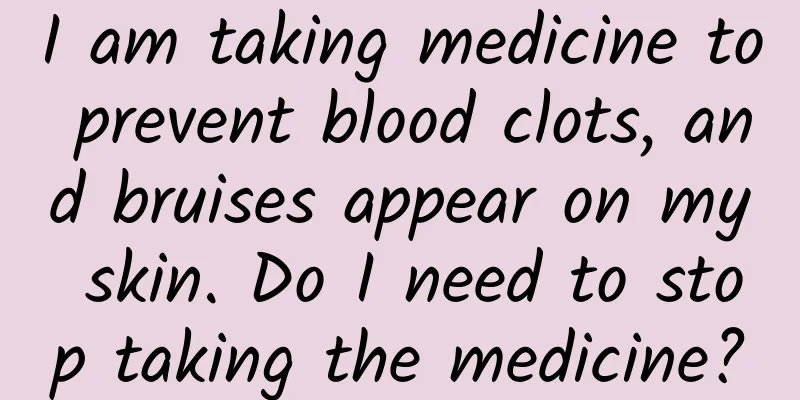I am taking medicine to prevent blood clots, and bruises appear on my skin. Do I need to stop taking the medicine?

|
A friend consulted Huazi. After taking anti-thrombotic drugs, he always had inexplicable bruises on his body. Was it because the drugs reduced his blood coagulation function too much? Would there be any problems? Could he continue to take the drugs? Huazi advised him that he did not need to stop taking the medication for the time being, but he should go to the hospital to check his platelets, coagulation factors and coagulation function to see if there were any abnormalities, and then adjust the medication based on the results. 1. Drugs to prevent thrombosis can easily cause subcutaneous bleeding Thrombotic disease can be said to be the "number one killer" threatening human life. Many people suffer from coronary heart disease, myocardial infarction, cerebral infarction and other diseases, and have a high risk of cardiovascular and cerebrovascular diseases. In order to prevent accidents, drugs are needed for prevention. Depending on the cause of the disease, preventive medications are divided into antiplatelet drugs (represented by aspirin) and anticoagulant drugs (represented by warfarin). Regardless of which drug is used, it will interfere with the coagulation process and may cause spontaneous bleeding, mainly subcutaneous bleeding, which manifests as subcutaneous bruising. 2. Most subcutaneous bleeding will not be more serious Many patients who take anti-thrombotic drugs have reported skin bruising, but that is basically all, and no more serious adverse reactions will occur. There is even a view that the appearance of skin bruising proves that the drug has taken effect and can ensure the effectiveness of preventing thrombosis. Most people's bruises are not serious and can be relieved on their own, but bruises may recur. However, as long as there is no multi-system bleeding such as vomiting blood, blood in urine, blood in stool, black stool, deep hematoma, etc., it usually does not have a significant impact on health and does not require stopping medication. 3. Differentiate from bleeding caused by other reasons Subcutaneous bruises are not only adverse reactions caused by drugs, but also by other factors. Trauma is the most common cause, but some elderly people have insensitive nerves and cannot feel some small bumps, so they mistake bruises caused by trauma for adverse reactions to drugs. Some middle-aged and elderly people may suffer from blood diseases, which may lead to skin bruises, such as leukemia, aplastic anemia, hemophilia and other diseases. However, the bruises caused by these diseases are usually more serious, and are often accompanied by spontaneous bleeding in multiple systems. When blood is drawn for testing, blood indicators can be found to be obviously abnormal. IV. How to reduce adverse reactions caused by drugs Using drugs to prevent thrombosis is very important for people at risk of cardiovascular and pulmonary diseases, but many people are over-treating. While drug treatment produces benefits, it also has the risk of adverse reactions. Drug treatment is only recommended when the benefits outweigh the risks. For example, antiplatelet drugs can only be used when severe atherosclerosis is confirmed; anticoagulant drugs can only be used when atrial fibrillation cannot be converted to normal rhythm, or when there is a risk of venous thrombosis. The current treatment guidelines do not recommend preventive medication for healthy people who have not had thrombosis-related diseases. Before taking the medicine, a doctor needs to evaluate and screen for contraindications. For example, people with low platelets or coagulation disorders may not be suitable for drug treatment. Antiplatelet drugs often cause damage to the gastrointestinal mucosa, so people with gastrointestinal diseases should use the drug with caution or use it with gastric mucosal protection drugs. When used in combination with other drugs, the drugs may interact with each other and interfere with the effect of the thrombus prevention drugs. People who take other drugs need to explain in detail to their doctors before taking the drugs. During the medication process, keep a close eye on adverse reactions. If a small area of skin bruises occurs, it can be absorbed by itself and there is no need to stop the drug. If the bruise is large, you need to see a doctor in time to find out the cause. In summary, subcutaneous bleeding may occur when taking anti-thrombotic drugs. Minor, small bruises can be absorbed by themselves, and it is not recommended to stop taking the drug. If the bruise is large or systemic bleeding symptoms occur at the same time, you should seek medical attention in time and let the doctor determine whether you can continue to take the drug. The drug must be used under the guidance of a doctor. If you have any questions about the use of the drug, please consult a doctor or pharmacist. I am pharmacist Huazi. Follow me to share more health knowledge. |
>>: What is baby cabbage? How to avoid buying baby cabbage with formaldehyde
Recommend
IDC: China's smartphone shipments in Q2 2021 were approximately 78.1 million units, a year-on-year decrease of 11.0%
Market research company IDC today released the 20...
World Allergy Day | Contemporary “allergy crisis”: Why are our bodies becoming more and more sensitive?
Today is World Allergy Day. Every year on July 8,...
Can women infected with HIV get pregnant and have a baby?
All about HIV! HIV infection is a slow virus that...
eMarketer: Smartphone users in China are expected to account for 49.1% of the total population in 2018
199IT original compilation eMarketer estimates th...
Recurrence after polyp removal
We all know that the body is the capital of revol...
Zhang Huaping: Social New Media and Unstructured Big Data Analysis
About Zhang Huaping: Dr. Zhang Huaping is the dir...
If you don't feel heartache after a breakup, does that mean you don't love? What should girls do after a breakup?
A broken heart is a special emotional experience....
How to reduce postpartum heat
Women should pay attention to changes in their bo...
What changes will happen to your body if you eat sauerkraut frequently? Does sauerkraut really cause cancer?
Sour radish, sour cowpea, sour cucumber... Just l...
Female body acupuncture points map
From the high-definition pictures of the meridian...
Is it better for pregnant women to have a thick or thin belly?
We all know that in life, many pregnant women pay...
Can I eat Artemisia selengensis during menstruation?
Menstruation is very important to women and shoul...
What does pelvic ultrasound check?
The pelvic cavity is a very important reproductiv...
Pictures of inverted nipples during pregnancy
Inverted nipples confuse many pregnant women beca...









